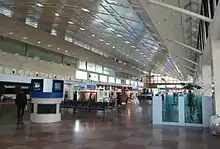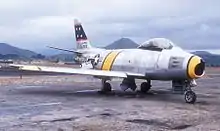Daegu International Airport
Daegu International Airport (Hangul: 대구국제공항; Hanja: 大邱國際空港; Revised Romanization: Daegu Gukje Gonghang; McCune-Reischauer: Taegu Kukche Konghang) (IATA: TAE, ICAO: RKTN) is the international airport serving the city of Daegu and the surrounding area in the southeast of South Korea. The airport is also a military base for the ROKAF's 11th Fighter Wing, whose three squadrons fly the F-15K.
Daegu International Airport 대구국제공항 大邱國際空港 Daegu Gukje Gonghang Taegu Kukche Konghang | |||||||||||||||
|---|---|---|---|---|---|---|---|---|---|---|---|---|---|---|---|
 | |||||||||||||||
| Summary | |||||||||||||||
| Airport type | Public / Military | ||||||||||||||
| Owner | Ministry of Land, Infrastructure and Transport | ||||||||||||||
| Operator | |||||||||||||||
| Serves | Daegu | ||||||||||||||
| Location | Dong District, Daegu, South Korea | ||||||||||||||
| Opened | 1 April 1961 | ||||||||||||||
| Elevation AMSL | 116 ft / 35 m | ||||||||||||||
| Coordinates | 35°53′39″N 128°39′32″E | ||||||||||||||
| Website | www.airport.co.kr/daegu | ||||||||||||||
| Map | |||||||||||||||
 TAE Location of airport in South Korea | |||||||||||||||
| Runways | |||||||||||||||
| |||||||||||||||
| Statistics (2019) | |||||||||||||||
| |||||||||||||||
Statistics from KAC[1] | |||||||||||||||
Overview
The airport chiefly serves domestic routes with a small number of international flights. Despite the growth of the nearby city of Daegu, passenger numbers at Daegu International Airport have been steadily declining since 2004, the year when KTX highspeed rail reached the city. The 2013 number of about 1.1 million passengers is around half of pre-2003 figures. Since in 2014, passenger numbers have increased sharply due to the expansion of Low-Cost Carriers.
History
Daegu International Airport was originally established under Japanese rule as Taegu Airfield on 31 January 1937.[2]
Korean War
At the outbreak of the Korean War, the airfield consisted of a dirt and gravel runway and two concrete buildings.[3] The airfield was designated by the USAF as K-2.
The airfield was used as part of the Bout One project, an emergency program to train Republic of Korea Air Force pilots to fly the F-51 Mustang. The Bout One planes provided close air support to the U.S. 24th Infantry Division through July 1950.[3]:89–90 On 10 July 1950, the Bout One force was re-designated as the 51st Fighter Squadron,[3]:95 and was merged into the 12th Fighter-Bomber Squadron on 4 August.[3]:112
The existing dirt and gravel runway was improved by the 822nd Engineer Aviation Battalion beginning on 18 July, and the Battalion subsequently began preparations for a parallel 5,000 foot (1,500 m) PSP runway on 7 August.[3]:110
USAF units based at Taegu from July–August 1950 included:
- 18th Fighter-Bomber Group, from July–August 1950, subordinate units included:
- 12th Fighter-Bomber Squadron operating F-51 from 15 July 1950[3]:95
- 51st Fighter Squadron (Provisional) from 10 July–August 4, 1950[3]:95
- 6002nd Air Base Squadron from July–8 August 1950[3]:95
- 6147th Tactical Control Squadron (Airborne) operating T-6 Mosquitos from 1 August–September 6, 1950[3]:106
- 6149th Air Base Unit from August 1950
Taegu Airfield was abandoned following the North Korean attack on Taegu in mid-August 1950, but USAF units began reoccupying the base by 23 September 1950.[3]:176 The 822nd Battalion had returned to Taegu on 17 September and soon resurfaced the original dirt and gravel runway with PSP and extended its length to 5,700 feet (1,700 m).[3]:177
USAF units based at Taegu from September 1950 included:[3]:177
- 49th Fighter-Bomber Group operating F-80s from 1 October 1950. This was the first jet unit to be based in Korea. Subordinate units included:
- 7th Fighter-Bomber Squadron from 28 September
- 8th Fighter-Bomber Squadron from 29 September
- 9th Fighter-Bomber Squadron from 29 September
- 543rd Tactical Support Group from 26 September, subordinate units included:
- 8th Tactical Reconnaissance Squadron, Photo-Jet operating RF-80s from 2 October
- 162nd Tactical Reconnaissance Squadron, Night Photo from 8 October
- 363rd Reconnaissance Technical Squadron from 4 October
In May 1951, the 930th Engineer Aviation Group began repair work on the PSP runway and commenced construction of a 9,000 feet (2,700 m) concrete runway.[3]:395
Passenger facilities

The relatively small passenger terminal boasts a comfortable environment through its adoption of traditional design elements symbolizing Ouga (The song of five friend: water, rock, pine, bamboo, and moon; by Yun Seon Do), and its crane-like structure. The parking lot can accommodate about 1,097 cars and has a fully automated parking system; it opens from 6 am to 10 pm.[4]
Airlines and destinations
Access
The airport is 1.34 km from Ayanggyo Station (Daegu Subway Line 1) and can be reached by bus or taxi.
References
- "공항별 통계 : 항공통계 : 알림·홍보 : Kac 한국공항공사". Archived from the original on 20 January 2019. Retrieved 20 January 2019.
- Notice no. 40, 1937, Government-General of Korea. NDLJP:2959525/3
- Futrell, Frank (1983). The United States Air Force in Korea, 1950–1953 (PDF). Air Force History & Museums Program. p. 89. ISBN 9780912799711.
 This article incorporates text from this source, which is in the public domain.
This article incorporates text from this source, which is in the public domain. - "Information for parking lot". Archived from the original on 15 March 2008.
- "China Eastern adds new international routes from Weihai in May 2019". routesonline. Retrieved 24 April 2019.
- Liu, Jim. "FlyGangwon adds Yangyang – Daegu service from mid-August 2020". Routesonline. Retrieved 29 July 2020.
- https://www.routesonline.com/news/38/airlineroute/285715/jeju-air-adds-daegu-cebu-service-from-mid-sep-2019/
- https://en.yna.co.kr/view/AEN20200224002053320?section=coronavirus/news
- "Jeju Air expands Taipei network from late-Dec 2018". Routesonline. Retrieved 15 November 2018.
- Liu, Jim. "Jin Air adds new domestic routes in 2Q20". Routesonline. Retrieved 26 May 2020.
- "진에어, 국내선 또 늘린다…31일부터 김포∼대구 등 3개 취항" (in Korean). Yonhap News Agency. 16 July 2020.
- "Sichuan Airlines adds Dayong – Korea routes in W19". routesonline. Retrieved 17 October 2019.
- https://www.twayair.com/booking/schedule/getFlgtSched.do?depAirport=TAE&arrAirport=CRK%5B%5D
- "T'Way Air adds Daegu – Hanoi from late-Nov 2018". routesonline. Retrieved 30 October 2018.
- Liu, Jim. "T'Way Air adds Kalibo service from Oct 2019". Routesonline. Retrieved 10 September 2019.
- Duy Nhat (28 March 2019). "Dự kiến mở thêm đường bay thẳng từ Cam Ranh tới Hàn Quốc". Khanh Hoa Newspaper (in Vietnamese). Retrieved 5 April 2019.
- Liu, Jim. "T'Way Air adds Daegu – Vientiane service in W19". Routesonline. Retrieved 30 December 2019.
- Vietjet Air adds Da Nang – Daegu service from late-June 2018 Routesonline. 11 April 2018.
![]() This article incorporates public domain material from the United States Air Force website https://www.af.mil.
This article incorporates public domain material from the United States Air Force website https://www.af.mil.





